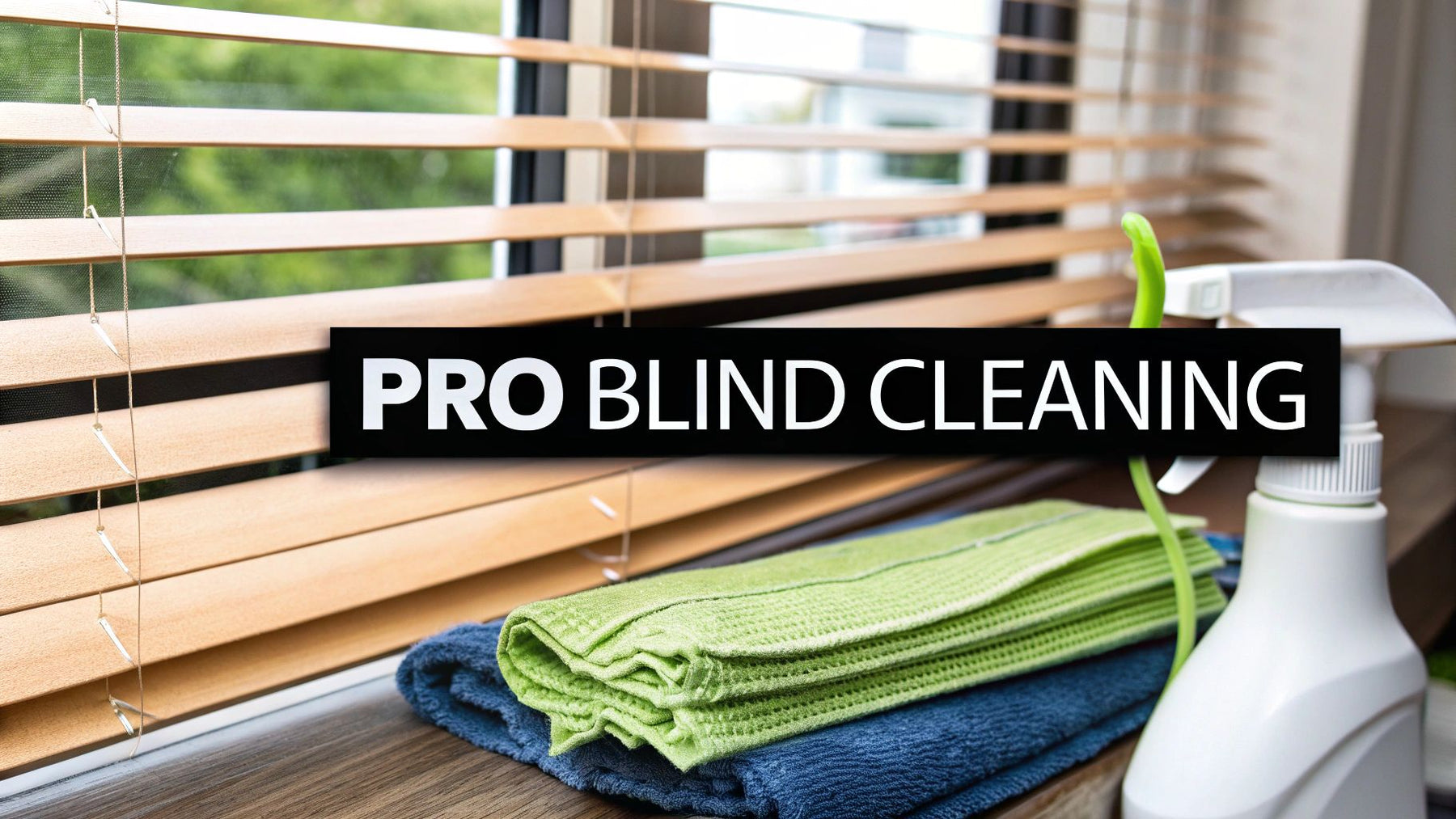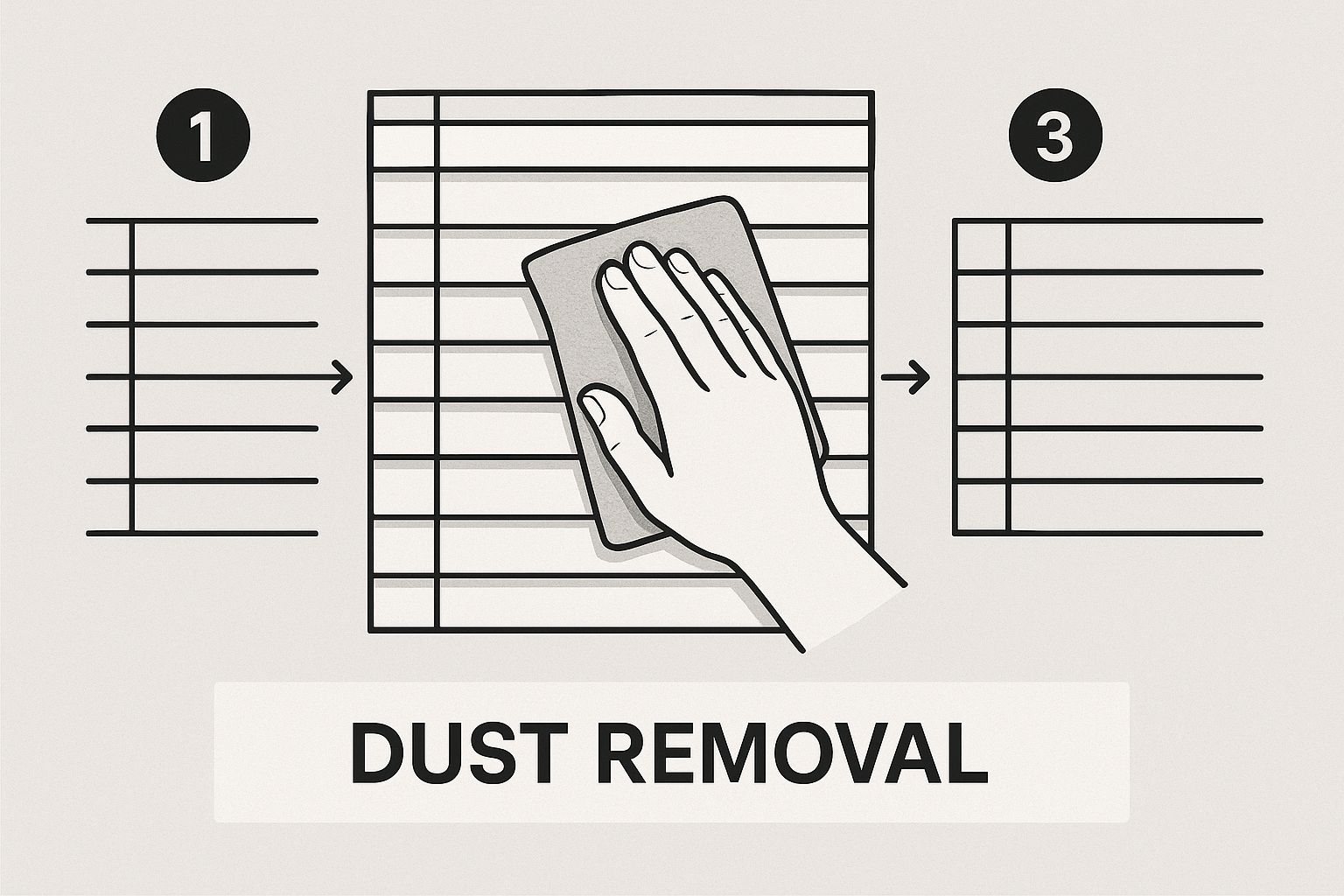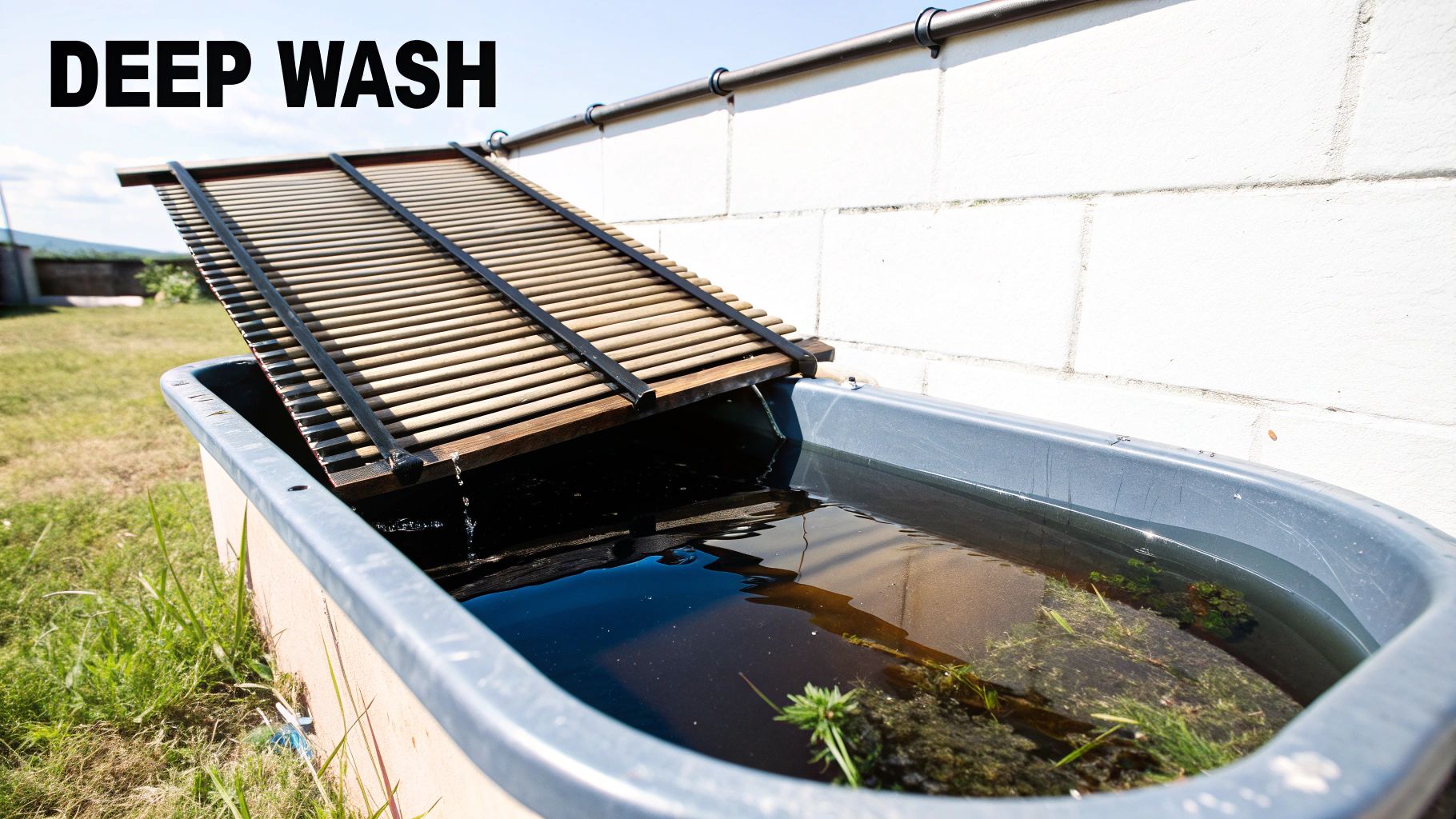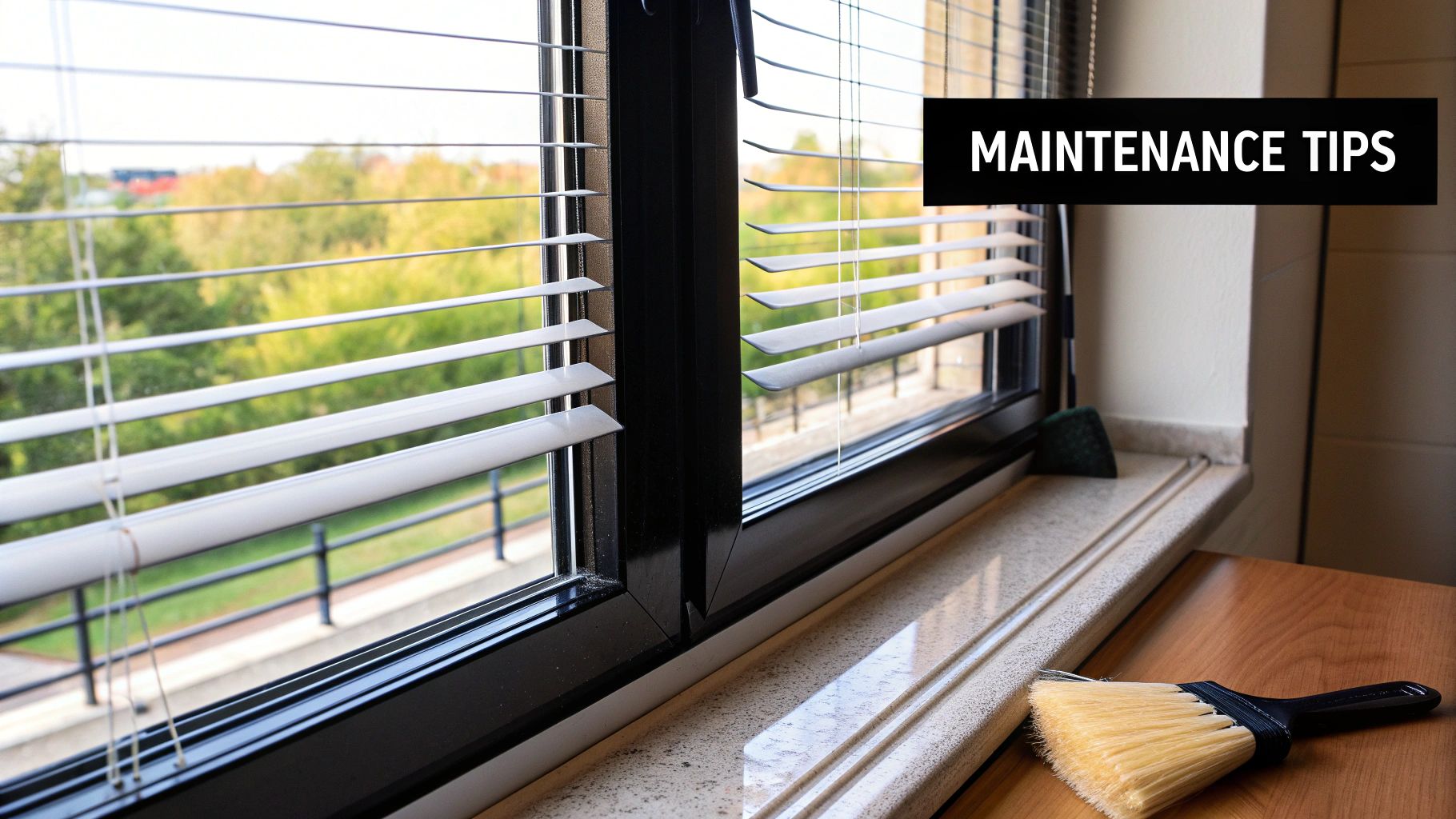
How to Clean Venetian Blinds: A Complete Guide
Venetian blinds are fantastic for controlling light and privacy, but let's be honest—they're absolute dust magnets. Knowing how to clean Venetian blinds properly not only keeps them looking sharp but also improves your home's air quality. While a quick weekly dusting helps, this guide provides a clear, step-by-step plan for tackling any level of grime.
We'll cover everything from a quick dust-off to a restorative deep clean, ensuring your window treatments look brand new.
Table of Contents
- Why Bother with Regular Blind Cleaning?
- Gathering Your Venetian Blind Cleaning Kit
- How to Clean Venetian Blinds: Choosing Your Method
- Cleaning Blinds Based on Material Type
- Tips for Keeping Your Blinds Looking Brand New
- Frequently Asked Questions About Cleaning Venetian Blinds
Why Bother with Regular Blind Cleaning?
Keeping your Venetian blinds clean isn't just about aesthetics; it's about creating a healthier home and protecting your investment. Over time, those slats collect an invisible cocktail of dust, pet dander, and allergens that can seriously impact your indoor air quality.
If you let that buildup go for too long, simple dust turns into stubborn, caked-on grime. It becomes a nightmare to remove and can even cause permanent stains or damage. A little consistent cleaning goes a long way in extending the life of your window treatments.
This focus on home hygiene is a growing trend. The global blind cleaning services market hit an estimated USD 1.2 billion in 2023, as detailed in this market report.
Understanding the Levels of "Clean"
Before you grab a sponge, it helps to know what level of cleaning you're aiming for. Each job requires a slightly different approach.
- Dusting: Your first line of defense. A quick, weekly dusting is the easiest way to prevent buildup.
- Wiping Down: Think of this as spot treatment. It's perfect for getting rid of fingerprints, smudges, or light grease spatters.
- Deep Cleaning: This is the heavy-duty wash for when your blinds are seriously grimy and a simple wipe won't cut it.
For a truly spotless finish, it helps to know what "clean" really means. Taking a moment for understanding the difference between cleaning and sanitizing will ensure you're not just moving germs around, but truly creating a healthier environment.
Gathering Your Venetian Blind Cleaning Kit
Getting your tools ready beforehand is the secret to a quick and painless cleaning session. Trust me, you don't want to be halfway up a ladder when you realize you forgot the microfiber cloths.
For a simple dusting, you can't go wrong with a good microfiber cloth. Its fibers create a static cling that grabs dust instead of just flicking it around the room. For an even faster job, a dedicated Venetian blind duster with its multiple fingers lets you clean several slats at once.
The Go-To Tools for Dusting and Wiping
Your vacuum cleaner is a huge help for settled dust. Just be sure to use the soft brush attachment. The wrong end can easily scratch or dent aluminum or vinyl slats, so a soft brush is non-negotiable for getting into nooks and crannies.
Here’s a quick checklist for your basic kit:
- Microfiber Cloths: Keep at least two handy—one for dry dusting and a second for damp wiping.
- Vacuum with Brush Attachment: Your best bet for a fast, mess-free dusting.
- A Bowl of Warm Water: You'd be surprised how often plain warm water is all you need for minor grime.
A Simple Mix for Stubborn Grime
For more than just dust—like the greasy film in a kitchen—you don't need harsh chemicals. A simple homemade solution often works best: mix equal parts white vinegar and warm water in a bowl or a spray bottle. It's a fantastic degreaser that's safe for common materials like aluminum, PVC, and vinyl.
A Quick Word of Caution: Before using any cleaning solution, even a natural one, always test it on a small, hidden area first. The top slat, usually covered by the valance, is a perfect spot. This step can save you from accidentally discoloring or damaging the finish, which is especially important for real wood.
How to Clean Venetian Blinds: Choosing Your Method
The best way to clean Venetian blinds depends on how dirty they are. Matching the right level of effort to the job at hand saves you time and ensures your window treatments get the care they need without unnecessary work.
Let's break it down into three practical levels. Before you start, this quick table will help you decide which cleaning approach your blinds actually need.
Which Cleaning Level Do You Need?
| Cleaning Level | Best For | Essential Tools | Time Commitment |
|---|---|---|---|
| Quick Dust-Off | Weekly maintenance & preventing buildup | Microfiber duster or vacuum with brush | 5-10 minutes per blind |
| Targeted Spot-Clean | Minor spills, smudges, or greasy fingerprints | Microfiber cloths, warm water, mild soap | 2-5 minutes per spot |
| Restorative Deep-Clean | Heavy buildup, seasonal cleaning, or neglected blinds | Bucket, microfiber cloths, mild soap, towels | 30-60 minutes per blind |
Once you've identified your mission, you'll know exactly what to grab and how much time to set aside. It’s all about working smarter, not harder.
The Quick Dust-Off for Regular Upkeep
A consistent, light dusting is the single best thing you can do to stop stubborn grime from ever taking hold. It’s a five-minute job that pays off big time.
For this, all you need is a microfiber duster or your vacuum with the soft brush attachment. Close the slats so they’re facing down and work your way from top to bottom. Then, flip the slats the other way and repeat. This simple motion gets the dust on both sides of each slat.

The key here is consistency. A quick wipe-down every week or so prevents tiny dust particles from turning into a much bigger cleaning headache.
The Targeted Spot-Clean for Minor Messes
For a little smudge, a fingerprint, or a small spill, a targeted spot-clean is your best friend. It’s the perfect way to handle isolated issues without cleaning the entire blind.
Just dampen a microfiber cloth with warm water. If you’re dealing with a greasy mark, add a single drop of mild dish soap. Gently blot or wipe the spot. Avoid aggressive scrubbing, as that can damage the finish, especially on wood or painted blinds.
Pro Tip: Always follow up with a separate, clean, damp cloth to wipe away any soap residue. Leaving even a tiny bit of soap behind can attract more dust, which completely defeats the purpose.
The Restorative Deep-Clean for a Total Refresh
When dust and grime have really built up, it's time for a deep clean. This method is more involved, but it’ll restore your blinds to a like-new shine. Many vinyl or aluminum blinds can be carefully taken down and washed in the bathtub.
But if taking them down sounds like a nightmare, you can still get a great deep clean while they hang. You'll need two bowls—one with your cleaning solution (warm water and a bit of mild soap) and one with plain rinse water. Wipe each slat with a cloth dipped in the cleaning solution, rinse with a second cloth dipped in plain water, and finally, dry each slat with a third, dry cloth.
If you want to learn more about different kinds of window treatments, read our guide covering the difference between blinds and shades.
Cleaning Blinds Based on Material Type
A one-size-fits-all approach to cleaning Venetian blinds is a quick way to ruin them. The key to getting them truly clean without causing damage is to recognize that wood, aluminum, and PVC each play by a different set of rules.
Using a wet-cleaning method on real wood can cause warping, while being too delicate with tough PVC might not get rid of all the grime. Let’s go over the right way to handle each type.
Caring for Real Wood Blinds
When cleaning real wood blinds, your guiding principle is: less is more, especially with water. Moisture is wood’s worst enemy and can cause swelling, warping, and discoloration. Never dunk wood blinds in water or douse them with a soaking wet rag.
The short answer is to always start with a dry cleaning method. A dry microfiber cloth or a vacuum’s soft brush attachment handles most day-to-day dust. If you encounter stubborn spots:
- Grab a clean cloth and lightly dampen it with a cleaner made specifically for wood.
- Wring the cloth out until it’s barely damp. Seriously, it should feel almost dry.
- Gently wipe the spot, and then—this is crucial—immediately buff it dry with a separate, clean cloth.

Tackling Aluminum and PVC Blinds
Aluminum and PVC (often called faux wood) blinds are the resilient workhorses of the window treatment world. These materials can stand up to a much more rigorous cleaning than real wood, so feel free to be more generous with water and gentle cleaning solutions.
My Go-To Deep Clean: For a really thorough cleaning, I take aluminum or vinyl blinds right off the window. Fill a bathtub with warm, soapy water and give each slat a good wipe-down with a soft cloth. After a quick rinse, I hang them over the shower curtain rod to drip dry completely before putting them back up.
This kind of durability is why we often recommend mini blinds for their practicality and easy maintenance.
Tips for Keeping Your Blinds Looking Brand New
Once you’ve put in the effort for a deep clean, the secret to keeping blinds pristine is adopting a few clever, consistent habits.
The best dusting method is the "flip and wipe." Tilt the slats all the way down and run your duster or vacuum brush from top to bottom. Then, flip the slats to face up and repeat. This simple motion gets both sides of every single slat.
Find Your Cleaning Rhythm
Consistency is key. A quick dusting every week or two will prevent 90% of the buildup that leads to a major cleaning project. Just make it a five-minute part of your regular tidying up.
If you're building better habits, looking into efficient house cleaning strategies can help create a system that works for your whole space.
Solving Annoying Blind Problems
Even with regular care, a few common issues can pop up. Here’s how to tackle them:
- Stubborn Kitchen Grease: For blinds near a stove, wipe them down once a month with a cloth dipped in a 50/50 mix of white vinegar and water. It cuts right through greasy film.
- Dingy Fabric Tapes: Stains on cotton tapes? A little upholstery cleaner or a dab of mild dish soap on an old toothbrush works wonders. Scrub gently, then blot with a clean, damp cloth to rinse.
- Tangled Cords: Lay the blind flat if you can. Start untangling from the bottom of the knot, slowly working your way up. Don't pull—that just makes the knots tighter.
Think of it this way: these small, regular actions aren't just about cleaning. They're about building a simple maintenance routine that saves you time and frustration down the road.
Frequently Asked Questions About Cleaning Venetian Blinds
Here are direct answers to some of the most common questions about how to clean Venetian blinds.

What is the fastest way to clean Venetian blinds?
The fastest way to clean Venetian blinds is with a vacuum cleaner. Use the soft brush attachment, close the slats completely, and vacuum from top to bottom. Then, flip the slats the other way and repeat. This removes surface dust in minutes without water or cloths.
Can I clean my blinds without taking them down?
Yes, absolutely. For most routine dustings and even deeper spot-cleaning, leaving blinds hanging is more efficient. A simple wipe-down with a microfiber cloth and a gentle cleaning solution works perfectly while they're in place.
How do I clean the strings or cords on my blinds?
To clean grimy cords, dampen a microfiber cloth with a drop of mild soap. Pinch the cloth around the cord and gently pull it straight down. Follow up with a clean, damp cloth to wipe away any soap residue.
What should I do about mold or mildew on my blinds?
For mold or mildew, use a solution of one part white vinegar to four parts water. Apply it with a soft cloth, let it sit for about 10 minutes, and then wipe clean with a fresh, damp cloth. The most important step is to dry the slats completely to prevent regrowth.
My blinds are in a high, hard-to-reach window. Any tips?
For high windows, an extendable duster with a microfiber head is a lifesaver for regular dusting. For a deeper clean, a sturdy step ladder is non-negotiable for safety. If the blinds are particularly large or awkward, a proper installation makes all the difference. Our guide on how to measure windows for blinds can help ensure the fit is right.
